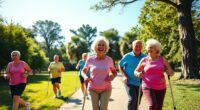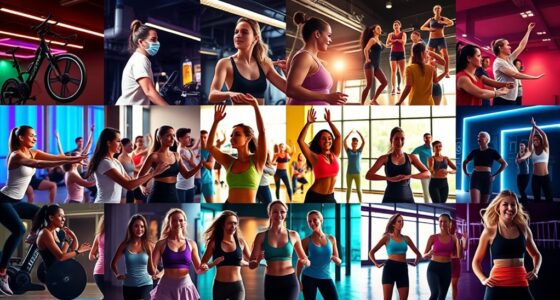Pilates is a fantastic low-impact exercise option for seniors looking to strengthen your core. By focusing on proper form and engaging your muscles, you’ll improve balance, flexibility, and posture while reducing the risk of falls. Incorporating breathing techniques adds mindfulness, enhancing your overall well-being. It’s all about taking small steps toward a stronger you. If you’re ready to discover more about effective techniques and community support in your Pilates journey, there’s plenty more to explore!
Key Takeaways
- Pilates offers low-impact exercises that enhance core strength, making it ideal for seniors looking to strengthen their core safely.
- Focus on proper form and core engagement techniques to maximize effectiveness and prevent injury during workouts.
- Incorporate glute bridges and pelvic tilts to target lower body strength while also engaging the core.
- Regular practice of Pilates promotes flexibility and balance, reducing the risk of falls and improving overall mobility.
- Joining a community or class provides support and accountability, making it easier to maintain a consistent practice.
Understanding the Benefits of Pilates for Seniors

As you age, staying active becomes increasingly important for maintaining your health and well-being.
Pilates is a fantastic low-impact exercise method that focuses on core strength, flexibility, and balance, making it ideal for seniors. By practicing proper form and controlled movements, you can improve your posture, which reduces the risk of falls and injuries. Engaging in regular physical activity can also enhance your overall respiratory health, supporting better lung function. Additionally, incorporating eucalyptus oil in your routine can help clear nasal passages, promoting easier breathing during Pilates sessions. Research shows that regular exercise can lead to improved cognitive function, which is vital for maintaining mental clarity as you age. Moreover, the emphasis on sustainable fashion aligns with the growing need for mindful living as you prioritize health.
Regular participation in Pilates can alleviate lower back pain, a common concern among older adults, by strengthening core muscles and promoting better spinal alignment.
Regular Pilates practice can help ease lower back pain in seniors by strengthening core muscles and enhancing spinal alignment.
Plus, the incorporation of breathing techniques enhances relaxation and stress relief, benefiting your mental well-being. With easy modifications available, you can participate safely, regardless of your fitness level, ensuring that everyone can enjoy the numerous benefits of Pilates. Additionally, regular physical activity is essential for preventing various health issues as you age.
Core Engagement Techniques for Stability
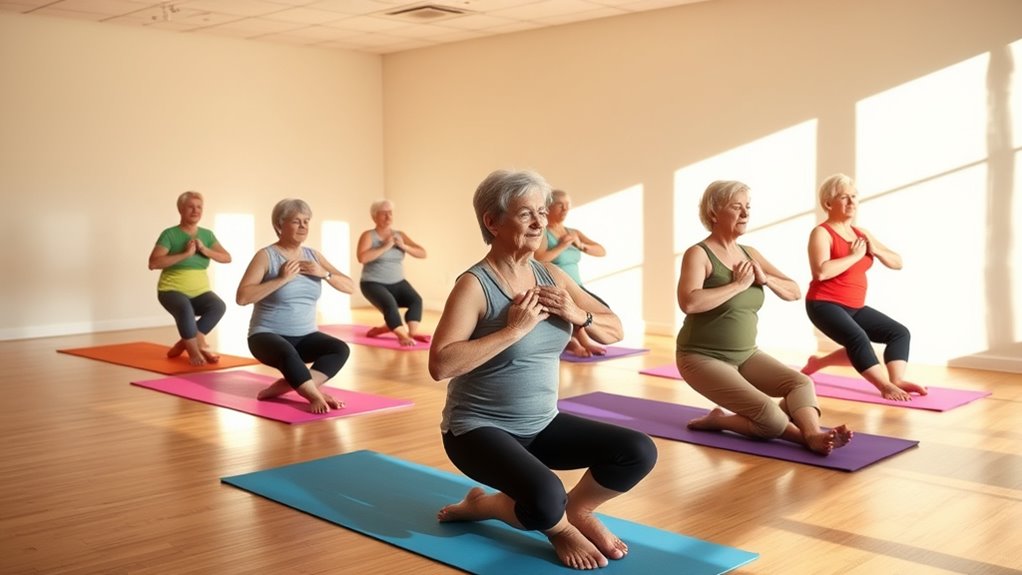
When you practice Pilates, proper form is essential for effective core engagement and stability. Focusing on your breathing techniques can also enhance this connection, helping you maintain control and alignment throughout your movements. Let’s explore how these elements work together to support your practice and overall strength. Incorporating HEPA filtration in your environment can further improve air quality, allowing for better focus during your workouts. Maintaining proper filter cleaning practices can also contribute to a healthier workout space. Additionally, engaging in mindfulness practices can enhance your self-awareness and connection to your body during Pilates, leading to improved performance and satisfaction in your practice. Creating designated zones for specific activities can also help maintain an organized and distraction-free workout environment. Utilizing low light office plants can also create a calming atmosphere, enhancing your overall workout experience.
Proper Form Importance
Proper form is vital in Pilates, especially for seniors looking to enhance their core stability. By maintaining proper form, you maximize core engagement and prevent injury.
Focus on the following techniques to guarantee ideal alignment and support your lower back:
- Keep your belly button pulled into your core during exercises.
- Position your elbows directly under your shoulders for back exercises.
- Use pelvic tilts to maintain lower back alignment. Incorporating core engagement techniques can alleviate lower back pain and improve your overall strength. Additionally, regular exercise can enhance emotional well-being for seniors, fostering a positive mindset and better quality of life. Participating in spiritual retreats can further contribute to emotional health and resilience. It’s important to recognize that emotional abuse can impact one’s mental state, making recovery essential after toxic relationships. Including healthy meal options in your diet, such as a Turkey Bean and Tomato Zoodle Bowl, can also support your fitness journey.
With consistent practice, you’ll not only enhance your stability but also promote long-term core health.
Breathing Techniques Explained
Engaging your core effectively requires more than just maintaining proper form; it also hinges on how you breathe during your Pilates practice.
Start with a deep breath, inhaling to prepare your body, and exhale fully to engage your core. This helps activate your muscles and aids in stability, protecting your lower back. A balanced diet rich in whole foods can also support your energy levels during workouts. Additionally, incorporating regular physical activity can enhance overall strength and flexibility, making your Pilates practice even more effective. Understanding your risk tolerance can also guide you in setting realistic fitness goals that align with your capabilities and lifestyle. Recognizing the importance of developmental milestones in physical activity can further motivate you to maintain a consistent practice.
As you perform movements, like pelvic tilts, check your form by keeping a straight back and pulling your belly button into your core. Remember to exhale during exertion and inhale during relaxation phases to enhance your practice.
Incorporating rhythmic breathing with exercises such as Dead Bug or glute bridges increases body awareness and improves coordination, ensuring peak effectiveness in your core-strengthening exercises. Additionally, being aware of your candle melting conditions can help create a comfortable environment for your practice, as excessive heat may distract from your focus.
Strengthening the Glutes and Legs

To enhance your lower body strength and stability, incorporating exercises that target the glutes and legs is essential, especially as we age. Engaging in regular physical activity is a key factor in promoting healthy aging. Studies show that maintaining a regular exercise routine can significantly improve energy efficiency in daily tasks, making activities feel easier and more manageable.
By focusing on glute bridges and leg lifts, you’ll not only build strength but also improve your balance and mobility. Regular exercise can also help address healthcare costs in retirement, allowing you to stay active and engaged.
Consider these effective exercises to strengthen your glutes and legs:
- Glute bridges: Perform slow and controlled lifts, adding pulsing at the top for extra activation.
- Pelvic tilts: Press your lower back against the mat to engage your core while activating your glutes.
- Leg lifts: With your heels together and toes apart, lift your back leg to foster glute engagement and enhance hip stability.
In addition to these exercises, it’s important to remain aware of financial considerations for elderly care, as they can impact your ability to maintain an active lifestyle.
These movements will help you maintain mobility and independence in your daily activities.
Effective Stretching and Flexibility Exercises
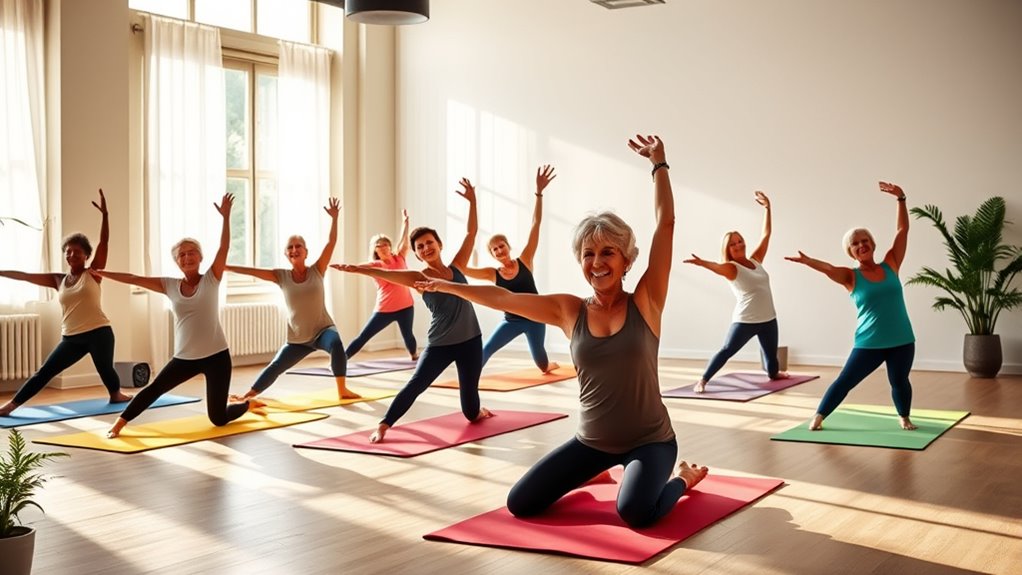
As you age, incorporating effective stretching and flexibility exercises into your routine becomes essential for maintaining mobility and preventing stiffness.
Start with the cat-cow stretch and child’s pose to promote spinal flexibility and ease lower back tension. In a seated position, practice core work with arm extensions to strengthen the core while enhancing upper body flexibility.
Don’t forget glute bridges; these slow, controlled movements not only strengthen the lower body but also improve hip flexibility. Additionally, side lying exercises like knee lifts and leg extensions engage your glutes and boost pelvic stability.
Regularly practicing these flexibility exercises can greatly enhance your overall physical well-being and help alleviate stiffness you might experience.
Stay nice and tall, and enjoy the benefits!
Safe and Supportive Workout Environment
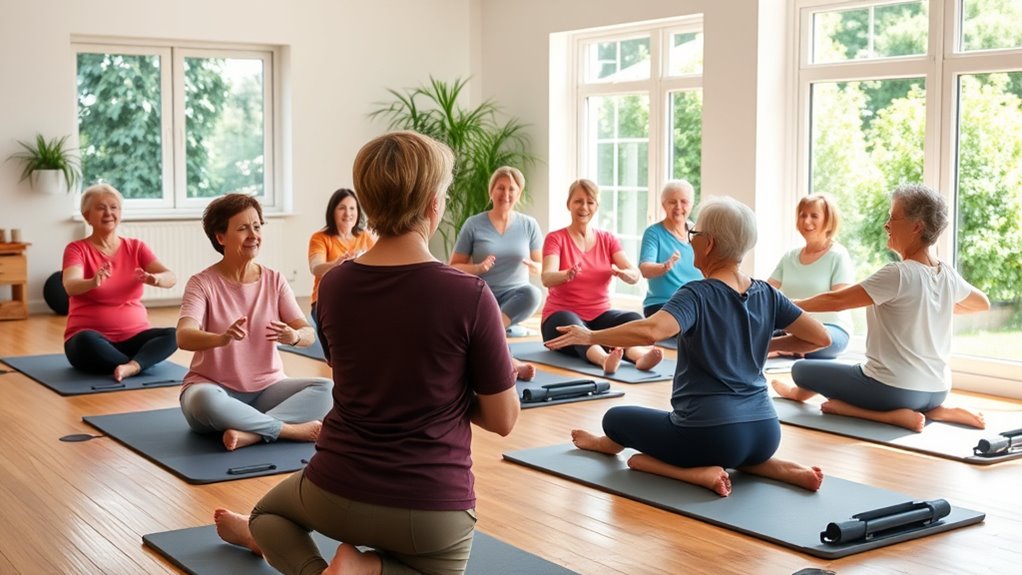
Creating a safe and supportive workout environment is essential for seniors, especially when practicing Pilates. This environment allows you to engage in core-strengthening exercises comfortably and confidently.
Here are some key elements to reflect on:
- Focus on proper form and alignment to minimize injury risk.
- Utilize the low-impact nature of Pilates, accommodating various fitness levels with modifications and adjustments.
- Incorporate breathing techniques to foster relaxation and enhance overall well-being.
Building Community Through Regular Participation
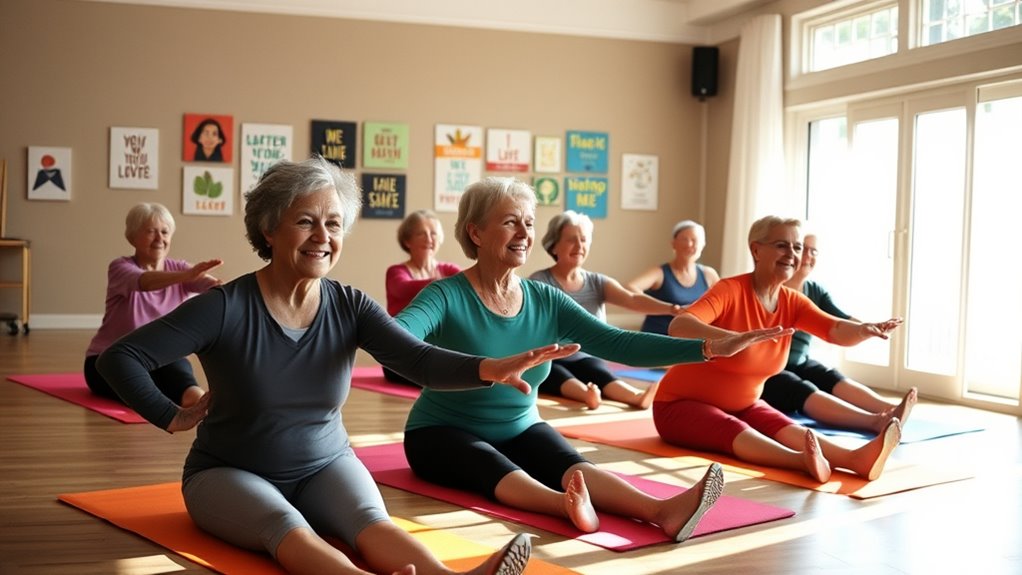
Participating regularly in Pilates classes not only boosts your physical health but also cultivates a strong sense of community among attendees.
As you engage in group sessions, you’ll find accountability that keeps you dedicated to your core health. Sharing your fitness journey with others fosters relationships that provide essential support and encouragement.
This welcoming environment helps seniors feel comfortable, making it easier to join in and stay committed. Celebrating each other’s progress becomes a shared experience, further strengthening bonds within the community.
When you attend classes together, you inspire one another, creating a network that nurtures personal growth and camaraderie. Embracing this community can transform your Pilates experience into a fulfilling and enriching journey.
Tips for Maintaining Proper Form

To get the most out of your Pilates practice, focusing on core engagement and proper alignment is essential.
Make sure you pull your belly button into your core and position your elbows under your shoulders during exercises.
This not only supports your lower back but also enhances your overall stability and effectiveness.
Core Engagement Techniques
While performing Pilates, engaging your core effectively is essential for maintaining proper form and preventing injury. Here are some techniques to help you achieve core engagement:
- Always pull your belly button into your core to provide lower back support.
- Position your elbows directly under your shoulders during back exercises to maintain proper alignment.
- Use pelvic tilts to guarantee lower back alignment and shift smoothly between exercises.
Focus on controlled movements, like lifting and lowering, to strengthen core stability.
During core exercises, elevating the opposite leg adds an advanced challenge that enhances overall strength.
Alignment and Breathing Tips
Proper alignment and breathing are essential for maximizing your Pilates practice. To maintain proper alignment, keep your belly button pulled into your core during all exercises. This core engagement supports your lower back and enhances your stability.
When performing back exercises, position your elbows directly under your shoulders to prevent strain. Incorporate pelvic tilts to guarantee lower back alignment, smoothly shifting into exercises like the dead bug for effective core activation. Elevate the opposite leg during certain movements for advanced core engagement and enhanced strength.
Focus on controlled breathing: inhale deeply as you move into positions and exhale during exertion. This approach will help you maintain stability and maximize the effectiveness of each exercise.
Encouragement for a Consistent Practice

Staying consistent with your Pilates practice can be incredibly rewarding, especially as you age. By making sure to start small, you’ll gradually build strength and flexibility.
Consistency in your Pilates practice brings rewarding benefits, particularly as you age; starting small allows for gradual strength and flexibility development.
Remember, as you engage in core-strengthening exercises, keep your knees stay aligned and your core stay lifted.
Consider these tips for maintaining a consistent practice:
- Set a regular schedule that fits your lifestyle.
- Join a community or class to share experiences and accountability.
- Focus on your breath—big deep inhales and exhales enhance mindfulness.
Frequently Asked Questions
How to Strengthen Your Core as a Senior?
To strengthen your core as a senior, start with gentle exercises like pelvic tilts and glute bridges.
These movements help build stability and alleviate discomfort. Incorporate the Dead Bug and knee plank press to engage your core while being mindful of your fitness level.
Remember to focus on maintaining proper form and breathing for best results. Regular practice will enhance your flexibility, reduce stiffness, and support a more active, independent lifestyle.
How Long Does Pilates Take to Strengthen the Core?
If you’re consistent with your Pilates practice, you’ll likely notice improvements in your core strength within 4 to 6 weeks.
By attending sessions 2 to 3 times a week, you’ll engage your muscles effectively, helping alleviate lower back pain and improve your posture.
Remember to focus on proper form and breathing techniques, as these will enhance your results.
As you progress, advanced modifications can challenge your core even further, speeding up your strength gains.
Is 70 Too Old to Start Pilates?
As the saying goes, “You’re never too old to learn.”
No, 70 isn’t too old to start Pilates! In fact, it’s a fantastic way to improve your core strength, flexibility, and balance.
Many seniors find that Pilates helps alleviate age-related issues like joint stiffness and back pain.
Plus, classes are easily modified to suit your fitness level, allowing you to progress comfortably.
Is 20 Minutes of Pilates a Day Enough?
Yes, 20 minutes of Pilates a day is enough to make a significant impact on your core strength and overall well-being.
This short, focused routine helps improve flexibility and stability, which are essential for daily activities. You’ll also find that this time commitment can alleviate discomfort, particularly in your lower back.
Plus, incorporating Pilates into your day fosters community and support, enriching your fitness journey and keeping you motivated along the way.
Conclusion
Incorporating Pilates into your routine can be a game-changer for your core strength and overall well-being. Think of it as nurturing a garden; with consistent care, you’ll see your stability and flexibility blossom. Embrace the journey, enjoy the camaraderie, and remember that every session brings you one step closer to a healthier you. So, roll out that mat, breathe deeply, and let the transformative power of Pilates guide you towards a vibrant life. You’ve got this!


